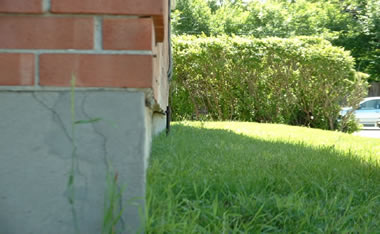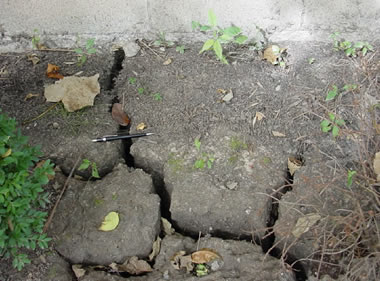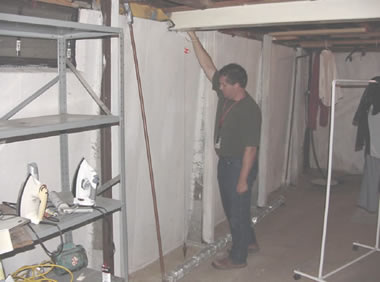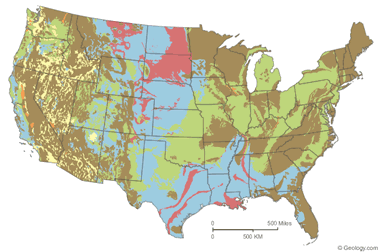 |
| Building damage: Note displaced bricks and inward deflection of foundation. |
Expansive Soil
and Expansive Clay
 |
| Cracks in expansive soil: Desiccation cracks in soil caused by drying. |
Article by: Hobart
M. King, Ph.D., RPG
What is an "Expansive Soil"?
Expansive soils
contain minerals such as smectite clays that are capable
of absorbing water. When they absorb water, they increase in volume.
The more water they
absorb, the more their volume increases. Expansions of ten percent or more are
not uncommon. This change in volume can exert enough force on a building or
other structure to cause damage.
Cracked
foundations, floors, and basement walls are typical types of damage done by swelling
soils. Damage to the upper floors of the building can occur when motion in the
structure is significant.
In a typical year in the United States, expansive soils cause
a greater financial loss to property owners than earthquakes, floods,
hurricanes, and tornadoes combined.
|
Expansive soils
will also shrink when they dry out. This shrinkage can remove support from
buildings or other structures and result in damaging subsidence.
Fissures in the
soil can also develop. These fissures can facilitate the deep penetration of
water when moist conditions or runoff occurs.
This cycle of
shrinkage and swelling places repetitive stress on structures, and damage
worsens over time.
How Many Buildings are at Risk?
Expansive soils are
present throughout the world and are known in every US state. Every year they
cause billions of dollars in damage.
The American Society
of Civil Engineers estimates that 1/4 of all homes in the United States have
some damage caused by expansive soils.
In a typical year in
the United States, they cause a greater financial loss to property owners than
earthquakes, floods, hurricanes, and tornadoes combined.
Even though expansive
soils cause enormous amounts of damage, most people have never heard of them.
This is because their
damage is done slowly and cannot be attributed to a specific event.
The damage done by
expansive soils is then attributed to poor construction practices or a
misconception that all buildings experience this type of damage as they age.
Homeowners Insurance and Expansive Soils
Damage to a home
caused by expansive soils can be catastrophic for a homeowner. Why?
Most homeowners
insurance policies do not cover damage caused by expansive soils. The cost of
repairs and mitigation can be extremely high - it sometimes exceeds the value
of the home.
In many cases the
homeowner noticed the problem, didn’t realize its severity, didn’t realize that
it was progressing, and the problem progressed to a point where repair didn’t
make economic sense.
Expandable, Shrink-Swell, Heavable Soils?
Expandable soils
are referred to by many names. "Expandable soils," "expansive
clays," "shrink-swell soils," and "heavable soils" are
some of the many names used for these materials.
The problem is so
unfamiliar to the average homeowner that they don't know what to call it.
Expansive Soils Map
The map on this page
shows the generalized geographic distribution of soils that are known to have
expandable clay minerals which can cause damage to foundations and structures.
It also includes soils that have a clay mineral composition which can
potentially cause damage.
How to Interpret the Map
The map is meant to
show general trends in the geographic distribution of expansive soils. It is
not meant to be used as a property evaluation tool. It is useful for learning
areas where expansive soils underlie a significant portion of the land and where
expansive soils might be a localized problem.
All construction
projects should include a soil analysis to identify the types of soil present
and determine their expansive properties. Local occurrences of expansive soils
can be found in all of the soil categories shown on this map.
Why Do These Soils Expand?
Soils are composed of
a variety of materials, most of which do not expand in the presence of
moisture.
However, a number of
clay minerals are expansive. These include: smectite, bentonite, montmorillonite,
beidellite, vermiculite, attapulgite, nontronite, and chlorite. There are also
some sulfate salts that will expand with changes in temperature.
When a soil contains
a large amount of expansive minerals, it has the potential of significant
expansion. When the soil contains very little expansive minerals, it has little
expansive potential.
Changes in Moisture Content Trigger Damage
When expansive soils
are present, they will generally not cause a problem if their water content
remains constant. The situation where greatest damage occurs is when there are
significant and repeated moisture content changes.
The Bottom Line
It is possible to
build successfully and safely on expansive soils if stable moisture content can
be maintained or if the building can be insulated from any soil volume change
that might occur.
The procedure for
success is as follows:
· Testing
to identify any problems
· Design
to minimize moisture content changes and insulate from soil volume changes
· Build
in a way that will not change the moisture conditions of the soil
· Maintain
a constant moisture environment after construction
Expert assistance is
usually needed to do these things successfully.
Hobart M. King, Ph.D., GIA GG
Hobart M. King is the owner and publisher
of Geology.com. He is a geologist with over 40 years of experience, has a Ph.D.
in geology, and is a GIA graduate gemologist. Much of his work has focused on
coal geology, industrial minerals, gemology, geologic hazards, and geoscience education.
He has authored many of the internet’s
most popular articles about rocks, minerals and gems. He writes most of the content
published on Geology.com and compiles its daily news. His writing is read by
over a million people each month, making him one of the world’s most widely
read geologists.
Dr. King earned a Ph.D. and an M.S. in
geology from West Virginia University; a B.S. in geology from California
University of Pennsylvania; and, a Graduate Gemologist Diploma from the
Gemological Institute of America. He is a registered professional geologist in
the Commonwealth of Pennsylvania.
He has worked as a geologist in a variety
of settings since 1975.
https://geology.com/articles/expansive-soil.shtml
 |
| Deflected basement wall: Inward deflection of a basement wall and pilasters. The plumb-bob reveals 9 inches of inward displacement. |
 |
Expansive soils map: The map above is based upon "Swelling Clays Map of the Conterminous United States"
|

No comments:
Post a Comment